| Listing 1 - 10 of 30 | << page >> |
Sort by
|
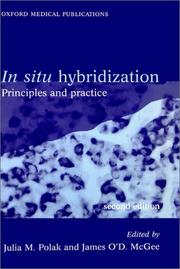
ISBN: 019854880X Year: 1998 Publisher: Oxford : Oxford university press,
Abstract | Keywords | Export | Availability | Bookmark
 Loading...
Loading...Choose an application
- Reference Manager
- EndNote
- RefWorks (Direct export to RefWorks)

ISBN: 0521380626 9780521380621 9780511629051 9780521282277 Year: 1990 Volume: 40 Publisher: Cambridge: Cambridge university press,
Abstract | Keywords | Export | Availability | Bookmark
 Loading...
Loading...Choose an application
- Reference Manager
- EndNote
- RefWorks (Direct export to RefWorks)
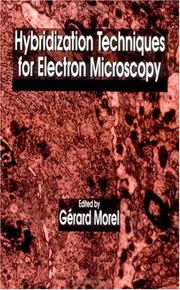
ISBN: 084934414X Year: 1977 Publisher: Cleveland CRC Press
Abstract | Keywords | Export | Availability | Bookmark
 Loading...
Loading...Choose an application
- Reference Manager
- EndNote
- RefWorks (Direct export to RefWorks)
Electron microscopy. --- In situ hybridization. --- Electron microscopy --- In situ hybridization --- Nucleic acid hybridization --- Microscopy
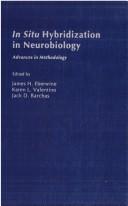
ISBN: 0195075072 Year: 1994 Publisher: New York (N.Y.) : Oxford university press,
Abstract | Keywords | Export | Availability | Bookmark
 Loading...
Loading...Choose an application
- Reference Manager
- EndNote
- RefWorks (Direct export to RefWorks)
In situ hybridization. --- Neurobiology --- Neurochemistry --- In Situ Hybridization --- Neurobiology. --- Methodology. --- methods.
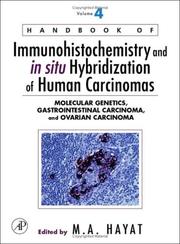
ISBN: 128064138X 9786610641383 0080457878 0123694027 9780123694027 Year: 2006 Publisher: Boston : Elsevier Academic Press,
Abstract | Keywords | Export | Availability | Bookmark
 Loading...
Loading...Choose an application
- Reference Manager
- EndNote
- RefWorks (Direct export to RefWorks)
Classical histology has been augmented by immunohistochemistry (the use of specific antibodies to stain particular molecular species in situ). Immunohistochemistry has allowed the identification of many more cell types than could be visualized by classical histology, particularly in the immune system and among the scattered hormone-secreting cells of the endocrine system. This book discusses all aspects of immunohistochemistry and in situ hybridization technologies and the important role they play in reaching a cancer diagnosis. It provides step-by-step instructions on the methods
Cancer --- Immunohistochemistry. --- In situ hybridization. --- Fluorescence in situ hybridization. --- Immunodiagnosis. --- FISH (Fluorescence in situ hybridization) --- Fluorescent in situ hybridization --- Fluorescence microscopy --- In situ hybridization --- Nucleic acid hybridization --- Immunohistology --- Histochemistry --- Immunochemistry --- Diagnosis --- Immunological aspects
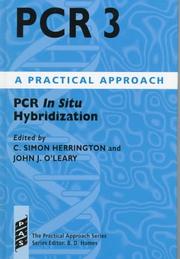
ISBN: 019963632X 0199636338 Year: 1998 Publisher: Oxford Oxford University Press
Abstract | Keywords | Export | Availability | Bookmark
 Loading...
Loading...Choose an application
- Reference Manager
- EndNote
- RefWorks (Direct export to RefWorks)
PCR 3: In Situ Hybridization is a unique and timely collection of well-tested protocols for the amplification of DNA and RNA in cells and tissues.
In situ hybridization --- Polymerase chain reaction --- Laboratory manuals.
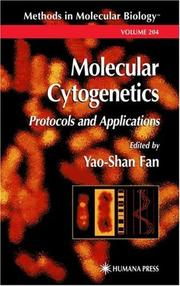
ISBN: 1588290069 9786610841875 1280841877 1592593003 Year: 2002 Publisher: Totowa, N.J. : Humana Press,
Abstract | Keywords | Export | Availability | Bookmark
 Loading...
Loading...Choose an application
- Reference Manager
- EndNote
- RefWorks (Direct export to RefWorks)
With the proliferation of fluorescence in situ hybridization (FISH) techniques as a powerful diagnostic tool in many areas of medicine, the variety and complexity of tests pose bewildering choices even for long-experienced laboratory technologists and physicians. In Molecular Cytogenetics: Protocols and Applications, Yao-Shan Fan and a panel of senior scientists and pioneering researchers describe in step-by-step fashion not only the leading FISH techniques, but also those molecular technologies beyond FISH now available for diagnostic services in genetics and oncology. The methods include labeling FISH probes for DNA and RNA targets, fluorescence genotyping, CGH microarray, spectral karyotyping/multicolor FISH, and primed in situ labeling. There are also techniques for multicolor fiber FISH, multi-telomere FISH, prenatal diagnosis using maternal blood, and preimplantation diagnosis. Oncological methods include simultaneous fluorescence immunophenotyping and FISH for leukemia and lymphoma, HER2 amplification in breast cancer, and CAC/PAC for cancer cytogenetics. Each easy-to-follow protocol offers first hand advice on how to obtain the best results, to avoid pitfalls, and to troubleshoot problems. Many protocols discuss possible future applications of the technology and explain its sensitivity and limitations. Cutting-edge and highly practical, Molecular Cytogenetics: Protocols and Applications offers laboratory physicians and scientists today's most comprehensive and up-to-date collection of FISH protocols for cancer diagnosis and investigation, plus an array of the emerging molecular technologies beyond FISH.
Fluorescence in situ hybridization --- FISH (Fluorescence in situ hybridization) --- Fluorescent in situ hybridization --- Cytogenetics --- Molecular genetics --- Fluorescence microscopy --- In situ hybridization --- Genetics --- Molecular biology --- Cytology --- Human genetics. --- Human Genetics. --- Heredity, Human --- Human biology --- Physical anthropology
Book
ISBN: 1780401779 1843392313 9781780401775 Year: 2009 Publisher: London : New York : IWA Publishing,
Abstract | Keywords | Export | Availability | Bookmark
 Loading...
Loading...Choose an application
- Reference Manager
- EndNote
- RefWorks (Direct export to RefWorks)
The FISH Handbook for Biological Wastewater Treatment provides all the required information for the user to be able to identify and quantify important microorganisms in activated sludge and biofilms by using fluorescence in situ hybridization (FISH) and epifluorescence microscopy. It has for some years been clear that most microorganisms in biological wastewater systems cannot be reliably identified and quantified by conventional microscopy or by traditional culture-dependent methods such as plate counts. Therefore, molecular biological methods are vital and must be introduced instead of, or in addition to, conventional methods. At present, FISH is the most widely used and best tested of these methods. This handbook presents all relevant information from the literature and, based on the extensive experience of the authors, advice and recommendations are given for reliable FISH identification and quantification.
Sewage --- Fluorescence in situ hybridization. --- FISH (Fluorescence in situ hybridization) --- Fluorescent in situ hybridization --- Fluorescence microscopy --- In situ hybridization --- Biological nutrient removal (Sewage treatment) --- BNR (Sewage treatment) --- Bioremediation --- Sewage disposal --- Purification --- Biological treatment. --- Biological treatment
Book
ISBN: 1281913863 9786611913861 3540705813 3540705805 9781281913869 9783540705819 Year: 2009 Publisher: Berlin, Heidelberg Springer Berlin Heidelberg :Imprint: Springer
Abstract | Keywords | Export | Availability | Bookmark
 Loading...
Loading...Choose an application
- Reference Manager
- EndNote
- RefWorks (Direct export to RefWorks)
This FISH application guide provides an overview of the principles and the basic techniques of fluorescence in situ hybridization (FISH) and primed in situ hybridization (PRINS), which are successfully used to study many aspects of genomic behavior and alterations. In 36 chapters, contributed by international experts in their particular field, the nowadays multiple approaches and applications of the powerful techniques are presented and detailed protocols are given. Described here are methods using various cell types and tissues as well as different organisms, such as mammalians, insects, plants and microorganisms. Multicolor FISH procedures and special applications such as the characterization marker chromosomes, breakpoints, cryptic aberrations, nuclear architecture and epigenetic changes, as well as (array-based) comparative genomic hybridization studies are presented. Overall, the technique of choice is introduced for single cell analysis in human genetics, microbiology, animal and plant sciences.
Fluorescence in situ hybridization. --- Genetics. --- Biology --- Embryology --- Mendel's law --- Adaptation (Biology) --- Breeding --- Chromosomes --- Heredity --- Mutation (Biology) --- Variation (Biology) --- FISH (Fluorescence in situ hybridization) --- Fluorescent in situ hybridization --- Fluorescence microscopy --- In situ hybridization --- Situ Hybridization, Fluorescence --- methods
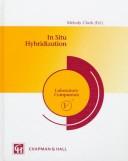
ISBN: 3826100387 Year: 1996 Publisher: London : Chapman & Hall,
Abstract | Keywords | Export | Availability | Bookmark
 Loading...
Loading...Choose an application
- Reference Manager
- EndNote
- RefWorks (Direct export to RefWorks)
In situ hybridization --- Gene Expression --- In Situ Hybridization --- Laboratory manuals --- methods --- Gene Expression. --- Laboratory manuals. --- methods. --- Methods.
| Listing 1 - 10 of 30 | << page >> |
Sort by
|

 Search
Search Feedback
Feedback About UniCat
About UniCat  Help
Help News
News